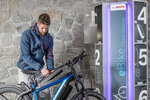ZachO
New Member
Hi All, from reading Court's reviews, there are many factors that impact a bikes's range. But if conditions and other factors were the same (wind, terrain, pedal assist mode, rider and bike weight, etc.) should two bikes with the same Bosch 500Wh battery and motor have approximately the same range? I would think so but I see that different manufacturers who have essentially the same drive train (motor and battery) advertise very different ranges even though the bikes all hover around 50lbs. Anyone have any inputs?
